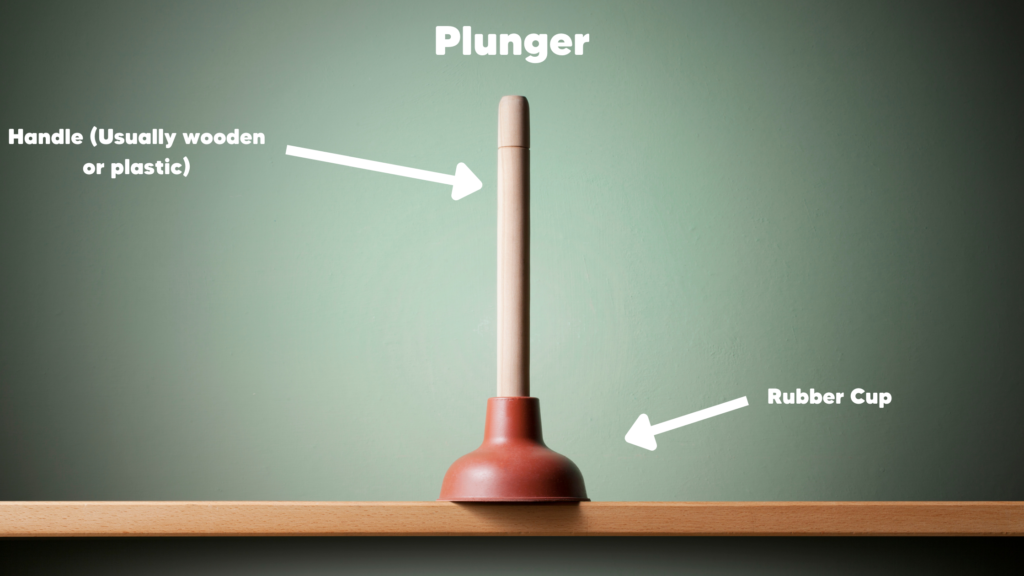When it comes to plumbing, there are many different devices and tools that can be used. One such tool is the plunger, which is often used to unclog drains. In this blog post, we will give you a brief overview of plungers and how they work.
What is a plunger?
A plunger is a plumbing tool that is used to clear blockages from pipes. It consists of a rubber cup that fits over the drain, and a handle that is used to apply pressure to the cup.
Common names for a plunger include plumber’s helper and force cup.

How does a plunger work?
Most plungers work with the use of manual pushing and pulling. When you push down on a plunger over a clogged drain, you are pushing air into the drain. This pushing is what increases the atmospheric pressure on the clog in the pipe. The pushing down of the plunger also creates a vacuum seal.
When you then pull the plunger up, the atmospheric pressure decreases. The vacuum seal then forces anything inside the pipe to move in the direction of the pull. This action is what unclogs drains.
Automatic plungers work differently. With an automatic plunger, you do not need to push and pull the plunger. An automatic plunger will work by pressing a button. When you press the button on the plunger, a burst of air or CO2 is released into the drain. This burst of air or CO2 will push on the clog and help to loosen it.
What are the different types of plungers?
There are many types of plungers:
- Sink Plunger/Cup Plunger – Sink plungers are the most basic type of plunger. They are made for hard flat surfaces, like a sink. Sink plungers may be used for toilets, but they won’t be as effective as a flange plunger.
- Toilet Plunger / Flange Plunger – Flange plungers are designed specifically for toilets. They look like sink plungers with one main exception. The exception is that flange plungers have a flange on the rubber cup. A flange helps to keep the plunger in place and to create suction when it is used on a toilet drain.
- Accordion Plunger – Accordion plungers look like accordions or a pair of bellows. Accordion plungers can apply quite a bit of pressure to a clog due to their unique design. But they can be a bit difficult for some people to use due to how challenging it is to create a vacuum seal.
- Taze Plunger – Taze plungers are specialized plungers mainly used by plumbers. Taze plungers consist of a disc and a steel rod and are used to clear large pipes.
- CO2 Plunger – CO2 plungers are a type of plunger that uses carbon dioxide to remove blockages. CO2 plungers use cartridges that release CO2. The release of CO2 acts as a powerful force that can clear clogs quickly. One example of a CO2 plunger is the Sureplunge.
- High-Pressure Air Plunger – Air plungers are a type of plunger that uses compressed air. Air plungers will come with an air reservoir that you fill with air. Once it is completely filled with air, you press a button on the air plunger and that compressed air is released.
- Beehive Plunger – A beehive plunger is a type of plunger that is designed for use in toilets. It has a conical head that fits over the drain hole in the toilet. It also has a long handle that allows you to reach down into the toilet bowl and push the plunger up and down. It was designed for both old and new toilets.
How do you use a plunger?
The way you use a plunger will vary on if it is a manual plunger or an automatic plunger.
If you are using a manual plunger, the process is simple. Make sure that the rubber cup is placed firmly over the drain. Then, use a plunging motion to push and pull the plunger up and down. You should feel resistance as the plunger forces the water down the drain. Keep going until the water starts to drain away.
If you are using an automatic plunger, the process is a bit different. You will need to read the instructions that come with your plunger. But the general idea is that you place the plunger over the drain and then press a button to activate it. The plunger will do all the work for you.
Are plungers bad for toilets?
The answer is no, plungers are not bad for toilets. In fact, they can be quite helpful in clearing up a clogged drain. However, if you use a plunger incorrectly, you could damage your toilet. The main way this damage could be caused is if you use too much force.
Don’t use too much force when plunging. This can damage the porcelain on your toilet bowl or crack the bowl itself. In addition, it can cause damage to the wax seal around the base of your toilet, which would lead to expensive repairs.
But it’s not just toilets you should be careful with. You should also avoid using too much force when plunging your sink or tub. If you have a wall mount sink, applying too much force can cause it to come loose from the wall.
Can I use a plunger on a sink?
Yes, you can use a plunger on a sink. Be sure to have separate plungers for your sink and toilet to avoid any issues with contamination.
Can plungers go bad?
As time goes on, plungers can become less effective. If your plunger becomes less effective, simply replace the old plunger with a new one.
Can I use a plunger in my bathtub?
Yes, you can use your plunger on your bathtub drain. All drains have a similar construction, and that includes bathtub drains and sinks.
Related Resources
Read More
Read More
Read More
Read More
Read More